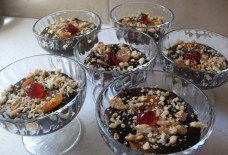Garlic: A Food and Medicine Throughout the Ages
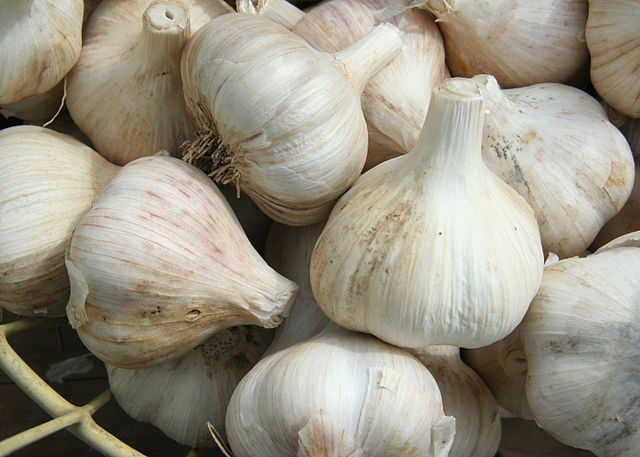
By: Habeeb Salloum/Arab America Contributing Writer
Through the centuries, people have either believed that garlic was divine or, with fanatical aversion, detested its very name. This well-known condiment with a unique flavour, not found in any other vegetable, has caused, and is still arousing much controversy. To admirers who adore the taste of garlic, it is the king of seasonings. On the other hand, ones who have a deep dislike for this pungent plant often quote an old proverb which says, ‘garlic makes men wink and drink and stink’.
An all-around flavouring and medical herb, it was one of mankind’s earliest foods. Garlic was first eaten in the Euphrates and Nile valleys about 5000 years ago. It is said that the workers who built the pyramids of Egypt were nourished by this herbal staple. It was also used as the medium of exchange in that early Pharaonic era and placed as an offering on the altars of the gods.
In ancient Rome, in spite of the fact that the upper classes detested this sapid vegetable, it was eaten in great quantities by the labourers. Historians from that epoch have written that it was fed to legionnaires before a battle to give them courage. The people in that age believed that garlic would cure over 60 diseases and also ward off the evil eye. This belief was carried into the Europe of the Middle Ages. In that era many maintained that if a cluster of garlic was worn around the neck it would keep at bay witches, vampires and other demons of the night.
However, not all food historians who mentioned garlic had kind words to say. One western writer who disliked it wrote that through the ages its strong odour had ended many a budding romance. King Alfonso of Castile in the 14th century had an extreme loathing for garlic. Hence, he ordered that any knight who had eaten this powerfully flavoured condiment not to appear before him for at least one month.
Nevertheless, the ardent dislike by a few for this ancient plant did not affect its wide use in food. The inhabitants of Asia and the countries surrounding the Mediterranean have used garlic in their cooking from the dawn of recorded history. These people from which almost all the known civilizations sprung know the beneficial and delicious taste of garlic and use it extensively in their cuisine. Today, Egypt, China, India, Thailand, and Spain are the largest growing and consuming countries of garlic in the world. On the other hand, in northern Europe and parts of North America, only in the last few decades has garlic become somewhat acceptable as a food.
The garlic plant is a hardy perennial with long leaves and white flowers tinged with purple. The bulb which can be white, pink, or mauve is the edible part. It consists of a number of cloves enclosed in a white outer skin. When the leaves begin to dry the bulbs are harvested and dried, then stored in a cool place.
Garlic contains water, carbohydrates, proteins, fats, thiamine, riboflavin, niacin and ascorbic acid. Its essential volatile oil has antiseptic properties which prevents the formation of bacteria and, hence, aids in the healing process of many diseases.
The medieval doctors and writers of the East all had praise for this food seasoning. To garlic they attributed many benefits. According to Arab writers, garlic gives strength, beautifies the complexion, acts as an aphrodisiac and helps cure hundreds of diseases. Long before modern medicine had been practiced in China, India and the Arab lands, the herb doctors prescribed garlic as a remedy for the common cold, senility, menstrual disorders, impotence and cancer.
Recent scientific evidence indicates that garlic truly has health benefits. Hence, the folk medicine of the herbalists in the past was based on solid foundation. As far bacl as 1980 (March 30) in an issue of the New York Times, Walter Sullivan wrote that during the last few years, Chinese doctors have used garlic as a substitute drug to treat meningitis. Thanks to these modern Chinese doctors one more ailment can be added to the list of those against which garlic has been reported effective or helpful. In the Soviet Union, allicin, a garlic extract, also known as Russian penicillin, is used as an antibiotic, and in a number of countries a little garlic juice is applied to pimples and boils to bring them to a head.
Other afflictions which are relieved by using garlic are: heart disease; high blood pressure; cancer; a high level of cholesterol; excessive sugar in the blood as in diabetes; and intestinal infections.
Yet, in spite of all its medicinal qualities, garlic in the majority of cases, is added to food to make dishes more flavourful and tastier. To the peoples of the Mediterranean Basin, most basic foods cooked without garlic are considered not worthy to be eaten. Only when a cook used the right amount of this vegetable condiment dishes, the cook becomes someone praiseworthy.
As to North America, there is no doubt that in the coming decades, when the benefits and food enhancing qualities of garlic become even better known, its use will spread. The one aspect which seems to retard its wider use in this continent is the offensive smell that it produces after being eaten. However, this can be eliminated by chewing a handful of parsley, or better still, if all members of a household eat food prepared with garlic. No one will be annoyed with the offensive odour if this pungent vegetable is eaten by all.
In the lands where garlic is extensively used, no one is offended by others who eat it almost daily. Rather, the quality of the dishes is immensely enhanced by its subtle use. Like no other seasoning people become addicted to its very name. Those in the Asiatic and Mediterranean countries who flavour appetizers, salads, soups, stews and all other types of meat and vegetable dishes with garlic, know the culinary outcome of this condiment. From their storehouse of mouthwatering delights, I have selected these few recipes.
Garlic Sauce – Thoum

There is no place in the world where garlic is more used and enjoyed than in the Middle East. A simple fiery garlic sauce called thoum is a common side dish in this part of the world. In the manner of mint sauce, horseradish, or ketchup as our common condiments, in the Arab world, no grilled chicken, meat or vegetable dish can be served without it.
2 heads of garlic, peeled
1/3 cup olive oil
1/3 cup lemon juice
1/2 teaspoon salt
- Place the garlic cloves in a blender and blend for a few moments, then add the remaining ingredients and puree until a creamy looking sauce is formed.
- Place in a jar or bottle with a tight-fitting lid and refrigerate until ready to use.
Sesame Sauce – Taratour
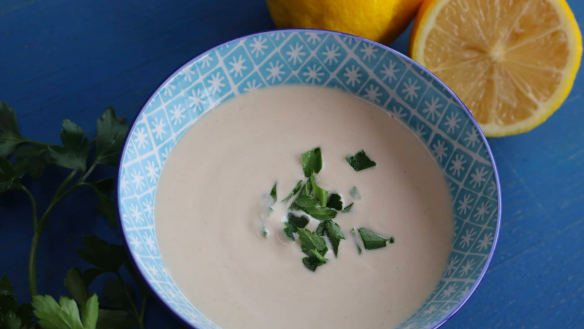
A little more subtle sauce, used mostly with fish or as an appetizer, is taratour. It adds a touch of the exotic to a meal.
1/2 head of garlic, peeled
1/2 cup taheena (sesame seed paste)
1/4 cup cold water
3 tablespoons lemon juice
1 tablespoon seeded, finely chopped hot pepper
1/4 teaspoon salt
1/4 cup finely chopped parsley
1 tablespoon olive oil
- In a blender, place the garlic cloves and blend for a few moments, then add the taheena, water, lemon juice, hot pepper and salt and puree.
- If desired add more water, a little at a time until the sauce becomes light in colour and the same texture as mayonnaise.
- Place in a serving platter and garnish with the parsley, then sprinkle with the oil.
- Cover and refrigerate for half an hour before serving.
Garlic Bread
4 tablespoons butter
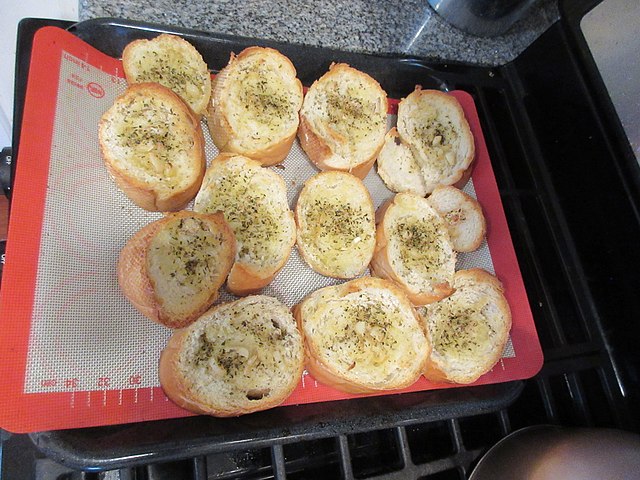
2 cloves garlic, crushed
1 tablespoon very finely chopped fresh coriander leaves
1 loaf French stick bread, cut into 3/4-inch-thick slices without cutting the bottom crust
- Mix the butter, garlic and coriander, then spread on both sides of the cut slices of bread.
- Wrap in aluminum foil, then bake in a 350o F preheated oven for 20 minutes.
- Serve hot.
Fried Tomatoes with Garlic – Banadoora Maqliya ma’a Thoum
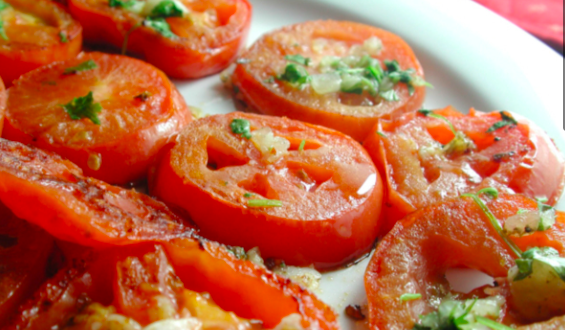
Serves 4
The best way to each this dish, is to scoop up each bite with a piece of Arabic bread.
4 cloves garlic, crushed
1/2 teaspoon salt
1/4 teaspoon black pepper
1/2 small hot pepper, seeded and very finely chopped
1 tablespoon finely chopped fresh coriander (cilantro)
2 tablespoons olive oil
2 large firm tomatoes, cut into 1/2-inch slices
- Thoroughly mix the garlic, salt, pepper, hot pepper, and coriander leaves, then set aside.
- In a frying pan, heat the oil over medium heat until the oil is steaming hot, then add half the tomato slices and fry for about a minute on one side.
- Remove from the heat and turn over the tomato slices, then sprinkle with half of the garlic mixture.
- Return to heat and fry for another minute, then turn the slices again and continue to fry until the tomatoes are cooked but not at the mushy stage.
- Slide the tomato slices onto a plate, then repeat the same process for the remaining portion of the recipe, adding more oil if necessary.
Eggplant Appetizer – Salatat Badhinjan
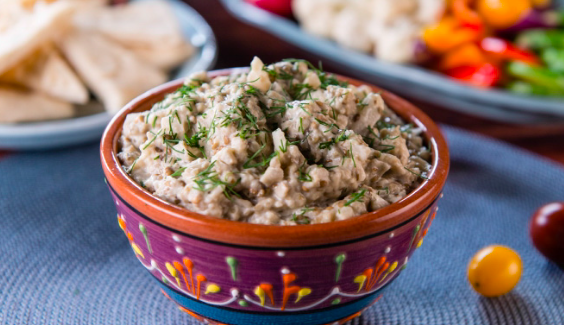
Serves 4
1 large eggplant, peeled and sliced into 1/2-inch-thick slices
1 teaspoon salt
1/2 cup olive oil
4 cloves garlic, crushed
1 small hot pepper, seeded and very finely chopped
2 tablespoons lemon juice
- Sprinkle the eggplant slices with the salt, then place in a strainer with a weight on top and let stand for 1 hour, allowing the juice to drain.
- In a frying pan, heat the oil, then sauté the eggplant pieces over medium heat on both sides until golden brown.
- Remove eggplant and dice, then place in a serving bowl, then add the remaining ingredients.
- Toss and slightly chilled just before serving.
Fried Liver with Garlic
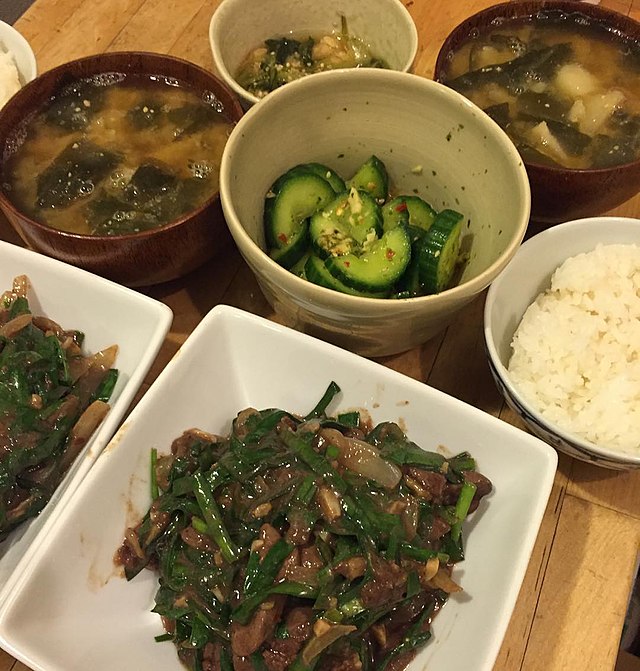
Serves 4
This is one of the best ways of preparing liver. The delicious taste of the liver is unequaled when compared to other methods of cooking.
4 cloves garlic, crushed
1 small hot pepper, seeded and very finely chopped
4 tablespoons very finely chopped fresh coriander (cilantro)
1/2 teaspoon salt
1/2 teaspoon black pepper
1/2 teaspoon allspice
4 tablespoons oil
1-pound calf liver, cut into 3/4-inch cubes
- Thoroughly mix the garlic, hot pepper, fresh coriander, salt, pepper, and allspice, then set aside.
- In a frying pan, heat the oil, then sauté the liver over fairly high heat until the liver begins to brown.
- Stir in the garlic mixture, then stir fry for a few minutes or until the liver is well-done.
Garlic Soup
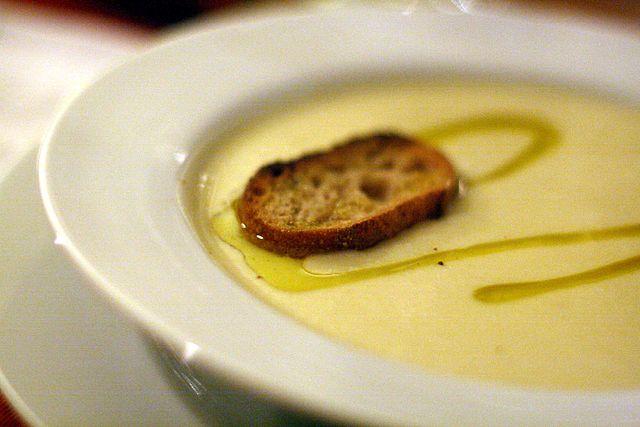
Serves 8
4 tablespoons olive oil
2 medium size onions, finely chopped
1 head garlic, peeled and finely chopped
1 small hot pepper, seeded and finely chopped
1 can stewed tomatoes (28 oz. 796 ml.)
5 cups water
1 teaspoon dried fennel
1 teaspoon dried oregano
1/2 teaspoon salt
1/2 teaspoon black pepper
1/2 teaspoon paprika
1/4 cup very finely chopped coriander (cilantro)
2 tablespoons lemon juice
2 cups croutons
- In a saucepan, heat the oil, then sauté the onions over medium heat until they begin to brown.
- Add the garlic and hot pepper, then stir-fry for about 3 minutes.
- Add the remaining ingredients except the coriander, lemon juice and croutons and bring to a boil, then cover and simmer over medium heat for 40 minutes.
- Stir in the coriander leaves and lemon juice, then serve piping hot with each person adding croutons to taste.
Garlic Omelet – Bayd ma’a Thoum
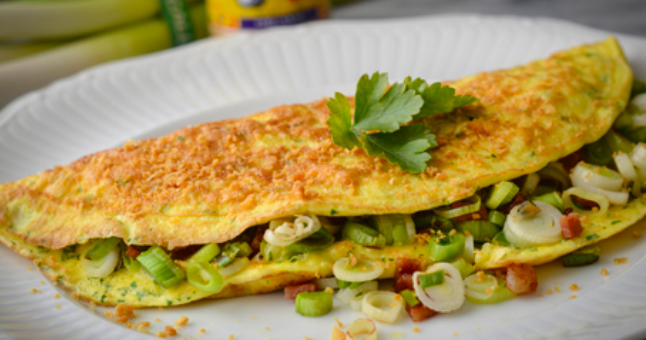
Serves 4
In the villages of Syria and Lebanon bayd ma’a thoum, a tasty garlic omelet, is served to a mother who has just given birth. It is believed that the garlic will purify the blood and speed the recovery after childbirth. Nevertheless, purifying the blood or not, this dish makes an excellent breakfast treat.
4 tablespoons olive oil
1 large head garlic, peeled and finely chopped
6 eggs
1/4 teaspoon salt
1/4 teaspoon black pepper
- In a frying pan, heat the oil, then stir fry the garlic over medium heat until golden brown.
- Remove from the heat, then remove garlic with a slotted spoon and set aside, reserving the oil in the frying pan.
- In a bowl, beat the eggs with a fork, then add the fried garlic, salt and pepper until thoroughly mixed.
- Pour into the frying pan and fry over low heat until the eggs are cooked.
Tomato-Sesame Paste Salad – Salatat Taheena
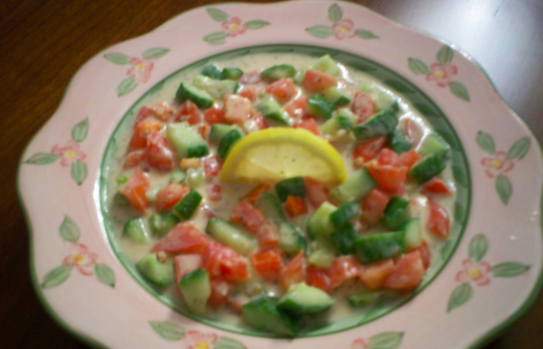
Serves 6 to 8
3 tablespoons taheena (sesame seed paste)
1/4 cup lemon juice
4 cloves garlic, crushed
1/2 teaspoon salt
1/4 teaspoon black pepper
pinch of cayenne
5 medium size tomatoes, finely diced
1 medium size cucumber, finely diced
1/2 cup finely chopped parsley
1 tablespoon finely chopped fresh mint
- In a serving bowl, thoroughly mix together the taheena, lemon juice, garlic, salt, pepper, and cayenne, then add the tomatoes, cucumber and parsley and toss.
- Garnish with fresh mint just before serving.
Garlic Meatballs – Muthawwim
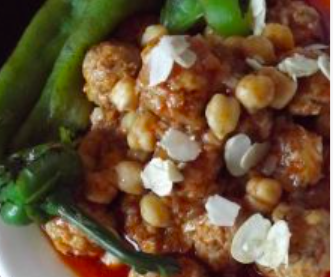
Serves 8 to 10
4 tablespoons butter
1 large onion, finely chopped
1-pound beef, cut into 1/2-inch cubes
1 head garlic, peeled and crushed
2 teaspoons salt
1 teaspoon black pepper
1 teaspoon cinnamon
1/8 teaspoon cayenne
4 1/2 cups water
1-pound ground beef
1/4 cup white rice, rinsed
1 bunch parsley, finely chopped
1 egg, beaten
4 tablespoons tomato paste
1 can chickpeas (19 oz. 540 ml.), with its water
- In a saucepan, melt the butter, then sauté the onions until they begin to brown
- Add the cubed meat, half the garlic, 1 teaspoon of the salt, 1/2 teaspoon of the pepper, 1/2 teaspoon of the cinnamon and cayenne, then sauté for a few minutes.
- Add the water and bring to a boil, then cover and simmer over medium heat for 45 minutes.
- In the meantime, thoroughly mix the ground beef, rice, parsley, egg, and the remaining garlic, salt, pepper and cinnamon.
- Form into small meatballs, then gently place the meatballs in the simmering saucepan.
- Bring to a boil, and simmer for about 15 minutes.
- Add the tomato paste and the chickpeas, then simmer over medium heat until the meatballs are well-cooked.
Serves 4
Garlic Rice Pilaf
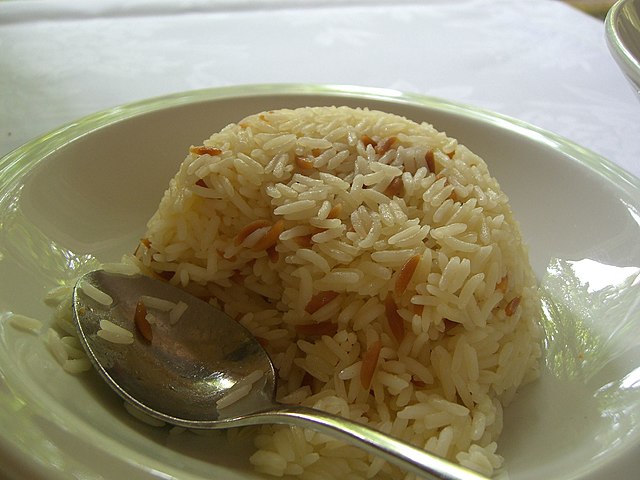
4 tablespoons butter
1 medium size onion, finely chopped
4 cloves garlic, crushed
1 cup white rice, rinsed
1 teaspoon finely chopped fresh oregano
1/4 teaspoon salt
1/4 teaspoon black pepper
1/4 teaspoon ground ginger
2 cups boiling water
2 tablespoons finely chopped fresh coriander (cilantro)
- In a frying pan, melt the butter, then sauté the onions over medium heat until golden brown.
- Add the garlic and sauté for further few minutes, then add the rice and stir fry for about 3 minutes.
- Stir in the remaining ingredients except the coriander, then bring to a boil and cover.
- Turn the heat to low and cook for 20 minutes, then turn off the heat and allow the rice to cook in its own steam for 15 minutes.
- Place on a serving dish and decorate with the coriander leaves and serve immediately.
Curried Fish

Serves 6
4 tablespoons olive oil
1 large onion, finely chopped
1/2 head garlic, peeled and finely chopped
1 small hot pepper, seeded and finely chopped
1/2 teaspoon grated ginger root
2 medium size tomatoes, chopped
4 tablespoons tomato paste
1/2 teaspoon salt
1/2 teaspoon black pepper
1/2 teaspoon turmeric
1/4 teaspoon ground cardamom
1/4 teaspoon cumin
1/4 teaspoon cinnamon
1/4 teaspoon nutmeg
pinch of cayenne
1 cup water
2 pounds fish filet, cut into pieces
- In a large frying pan, heat the oil, then add the onions, garlic, hot pepper, and ginger root and sauté until they begin to brown.
- Add the tomatoes and the tomato paste, then stir fry for about 3 minutes.
- Add the remaining ingredients except the fish pieces, then simmer over low heat for 30 minutes.
- Turn the heat to medium and add the fish pieces, then simmer for about 30 minutes or until the fish is cooked.
Note: Chicken may be substituted for fish.


